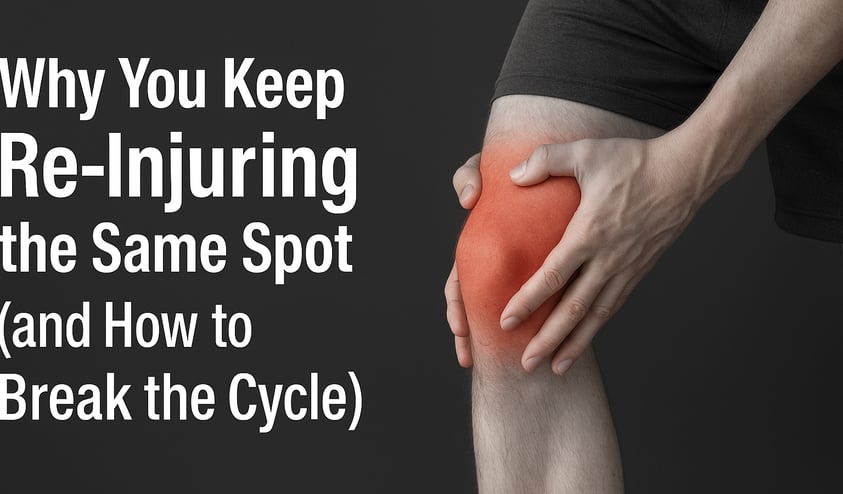Why You Keep Re-Injuring the Same Spot (And How to Finally Stop It)
Sick of getting hurt in the same spot over and over? Learn the real reasons behind recurring injuries—and how to break the cycle for good. Discover expert strategies, key rehab tips, and recovery tools to rebuild smarter and stay injury-free.
5/26/20253 min read


Why You Keep Re-Injuring the Same Spot (and How to Break the Cycle)
If you’ve ever felt like you're stuck in an injury loop—healing, getting back to training, then boom, same pain returns—you’re not alone. Re-injuring the same spot is one of the most common frustrations athletes face. It’s not just bad luck or being “accident-prone.” There are repeatable patterns behind it—and the good news is, they can be broken.
🎯 The Real Reason You Keep Getting Hurt Again
1. You Never Fully Rebuilt the Area
Just because the pain’s gone doesn’t mean the area’s ready. Most athletes return to activity too early, skipping full rehab. What happens? You train on a weak foundation. Muscle fibers aren’t fully rebuilt, connective tissue isn’t fully loaded, and the brain-body connection hasn’t relearned safe movement.
2. Your Movement Patterns Are Still Off
Injury changes how you move—sometimes subtly. Your body shifts weight away from painful areas, limits range of motion, and compensates. Even after healing, these altered patterns stick around and quietly overload other structures—or re-aggravate the same spot.
3. You’re Missing the Real Culprit
Injuries often stem from somewhere above or below the painful area. Bad ankle mobility can lead to chronic knee pain. A weak core can cause constant back flare-ups. If you don’t identify and treat the true source, you're just treating symptoms—and setting yourself up for the next round.
Product we recommend: Theragun Mini (Percussion Massage Gun)
Why it hits:
✔️ Increases blood flow to stubborn areas
✔️ Helps break up scar tissue + reduce tightness
✔️ Compact and great for daily recovery
Best used for:
• Pre-lift warmups
• Post-game soreness
• Targeting tension in hips, shoulders, calves
Step One: Rewire the Mind-Muscle Connection
When you injure a muscle or joint, your nervous system gets cautious. It limits activation and range—even after you’ve “healed.” That’s why regaining strength isn’t just about lifting heavier—it’s about reconnecting to movement. Start with slow, controlled reps and isometric holds. Use resistance bands to reintroduce tension safely and build confidence.
Product we recommend: Serious Steel Resistance Bands (Set)
Why it hits:
✔️ Easy on joints, great for rehab
✔️ Targets stabilizers and supports control
✔️ Use anywhere—home, gym, or warm-up zone
Best used for:
• Rebuilding strength post-injury
• Core/bracing drills
• Prehab and joint-friendly lifts
Step Two: Fix the Weak Links
If you keep hurting your knee, maybe it's your ankle. If it’s your shoulder, maybe it's your mid-back or core. True recovery means zooming out and strengthening the whole kinetic chain.
Quick checklist to look at:
Core not firing properly
Weak glutes or lats
Stiff ankles or hips
Limited T-spine rotation
Poor single-leg balance
A physical therapist can assess these—but you can also test movements yourself (e.g., balance on one leg, squat barefoot, check rotational tightness). Find what’s weak, and fix it before layering more training volume.
Product we recommend: TENS 7000 Digital TENS Unit
Why it hits:
✔️ Helps manage stubborn pain and inflammation
✔️ Easy to use at home after training
✔️ Boosts muscle activation and healing
Best used for:
• Chronic pain spots
• Nerve/soft tissue recovery
• Pain-free muscle reactivation
Step Three: Build Resilience, Not Just Strength
Don’t just strengthen the injured area—bulletproof it. Think in terms of durability:
Eccentrics: Slow, lengthening reps build tendon resilience
Isometrics: Holding tension strengthens joints without strain
Unilateral work: Single-leg or single-arm movements fix imbalances
Tempo work: Slowing down reps improves control + joint alignment
This isn’t flashy—but it works. You don’t need max weight to rebuild—you need consistency, precision, and progression.
Bonus: Recovery Doesn’t Mean Passive
Too many people treat recovery like rest-only. But recovery is active: mobility, breathwork, light movement, nervous system reset. You should be doing something every day that improves blood flow, restores range, or enhances coordination. A massage gun session, a banded mobility drill, even walking on an incline—these all count. Movement is medicine when applied with intention.
Final Take: Stop Guessing, Start Rebuilding
If the same pain keeps coming back, your body is telling you something. Don’t just push through or repeat the same rehab protocol. Zoom out. Reconnect. Rebuild. And this time—build it right.
The cycle stops when you stop skipping steps. Find the weak links. Re-pattern the movement. Stay consistent. That’s how you stop getting hurt—and start performing at your best.
FITNESS
Nutrition
WellnesS
info@movebetterco.com
© 2025. All rights reserved | Privacy Policy | Terms & Conditions